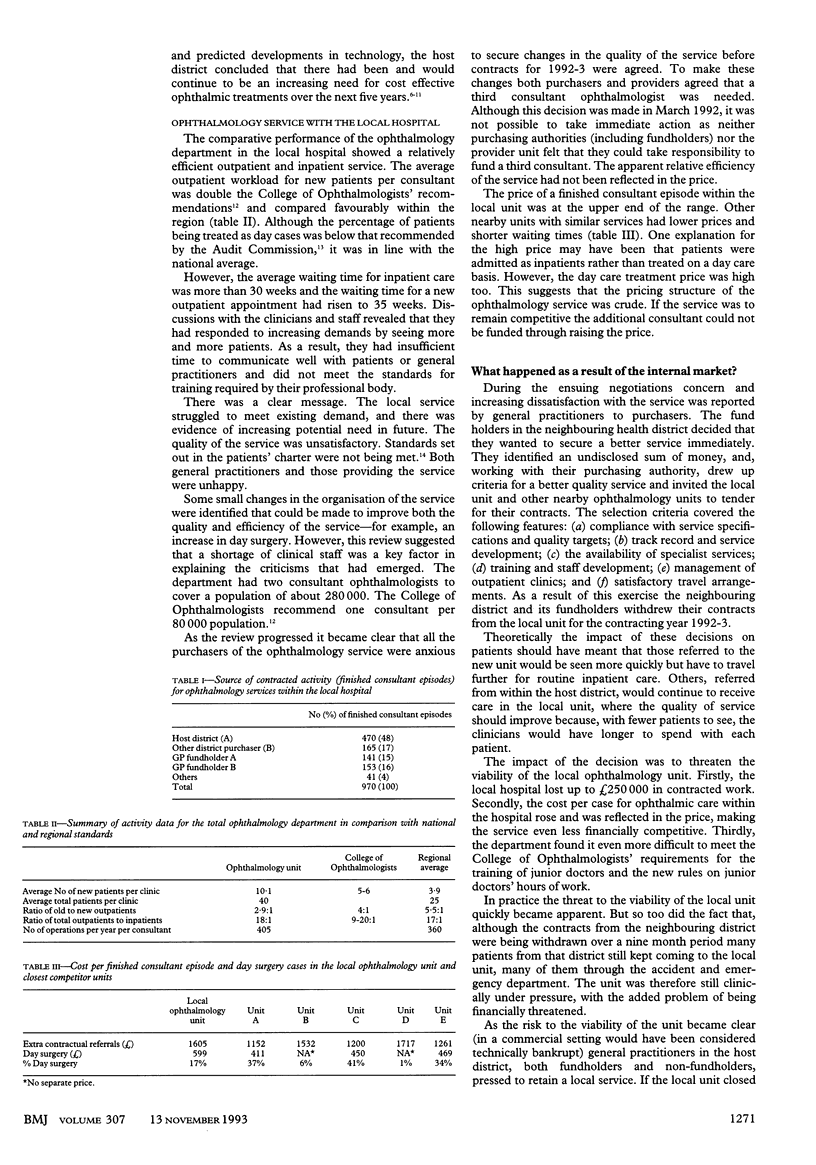Abstract
The internal market in the NHS is meant to ensure that provider units compete on the basis of price and quality and that money follows patients into efficient units. But the example of what happened to one local ophthalmology unit suggests what may go wrong when entrepreneurial activity is applied in a market that does not work perfectly. In 1991-2 the unit had a high workload but also comparatively high prices (because of crude pricing in the local hospital); because of pressure of work the waiting times lengthened and general practitioners increasingly complained about the service. The staff in the unit reopened a longstanding debate about the need for a third consultant ophthalmologist, but neither the purchasers (including fundholders) nor the provider unit were able to fund the post. Fundholders in a neighbouring district, however, together with that district health authority, decided to place their contracts elsewhere for the following year. Although the withdrawal of contracts jeopardised the clinical and financial viability of the ophthalmic unit, patients continued to use the service. When general practitioners in the district realised that their local service might collapse they pressed to keep the service open. The fundholders and the host purchaser finally agreed to fund a third consultant and drew up standards for the service. As a result the waiting times fell and the service is now described as "excellent." Short term market decisions may have unforseen long term implications for services to patients. This needs to be addressed as part of the evolution of the reformed NHS.
Full text
PDF


Selected References
These references are in PubMed. This may not be the complete list of references from this article.
- Ham C. What future for the regions? BMJ. 1992 Jul 18;305(6846):130–131. doi: 10.1136/bmj.305.6846.130. [DOI] [PMC free article] [PubMed] [Google Scholar]
- Kini M. M., Leibowitz H. M., Colton T., Nickerson R. J., Ganley J., Dawber T. R. Prevalence of senile cataract, diabetic retinopathy, senile macular degeneration, and open-angle glaucoma in the Framingham eye study. Am J Ophthalmol. 1978 Jan;85(1):28–34. doi: 10.1016/s0002-9394(14)76661-9. [DOI] [PubMed] [Google Scholar]
- Podgor M. J., Leske M. C., Ederer F. Incidence estimates for lens changes, macular changes, open-angle glaucoma and diabetic retinopathy. Am J Epidemiol. 1983 Aug;118(2):206–212. doi: 10.1093/oxfordjournals.aje.a113628. [DOI] [PubMed] [Google Scholar]
- Rosenthal A. R. The demand for ophthalmic services. BMJ. 1992 Oct 17;305(6859):904–905. doi: 10.1136/bmj.305.6859.904. [DOI] [PMC free article] [PubMed] [Google Scholar]
- Thomas H. F., Humphry R. Day surgery for cataracts. BMJ. 1992 Sep 5;305(6853):536–537. doi: 10.1136/bmj.305.6853.536. [DOI] [PMC free article] [PubMed] [Google Scholar]


